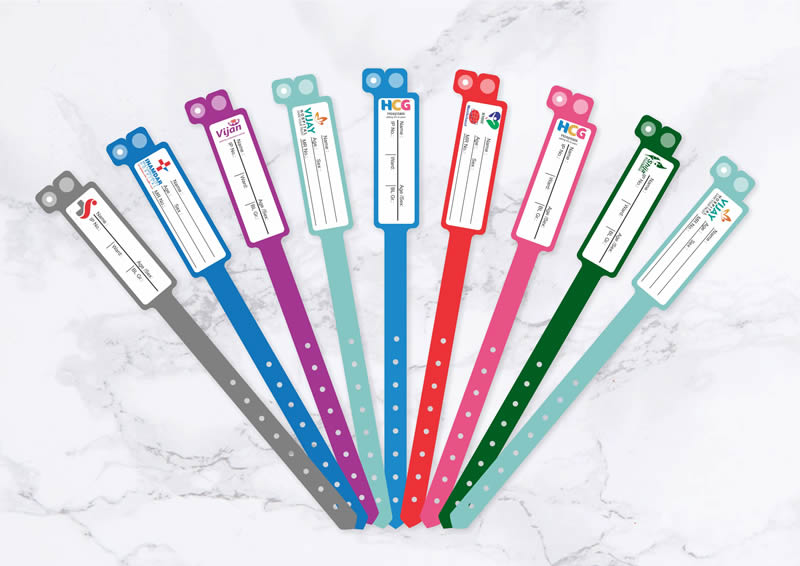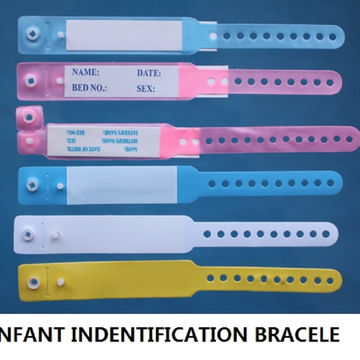Exactly How Patient Identification Band Enhances Patient Safety And Security in Medical Setups
Enhancing Security: The Significance of Patient Recognition Bands in Medical Care
In the realm of health care, the effectiveness of client identification bands can not be overstated, as they serve as a fundamental safeguard versus misidentification and succeeding mistakes. As we check out the diverse function of these bands, it becomes evident that their importance extends past plain recognition, increasing questions about ideal techniques and future innovations in client security.
Introduction of Individual Recognition Bands
Person recognition bands play an essential function in making certain the safety and accuracy of client treatment in medical care setups. These bands, commonly worn on the wrist or ankle, serve as a critical device for verifying patient identity, thus reducing the risk of errors in treatment, medication administration, and other health care procedures. Made from resilient materials, patient recognition bands often consist of vital info such as the client's name, date of birth, clinical record number, and barcodes or QR codes for scanning.
The implementation of client recognition bands is important in numerous health care environments, including medical facilities, outpatient centers, and long-term treatment institutions. They add to a systematic technique in patient administration, making it possible for health care specialists to quickly and precisely recognize clients, particularly in high-pressure scenarios where swift decision-making is essential.
Moreover, making use of these bands is lined up with regulative criteria targeted at enhancing client safety and security - Patient Identification Band. By ensuring that each client's info is easily verifiable and conveniently accessible, medical care companies can preserve a high standard of care, decrease the incidence of unfavorable events, and foster a society of safety and security within medical care establishments
Advantages of Accurate Recognition
Precise identification is fundamental to boosting person safety and security and care high quality in health care settings. It serves as the initial line of protection against errors that could bring about adverse person end results. By making certain that each person is properly determined with trustworthy ways, such as client identification bands, doctor can significantly decrease the danger of misidentification, which can result in unsuitable therapies, medicine errors, and also medical mix-ups.
Furthermore, exact individual identification facilitates reliable communication amongst health care teams. When all employee can consistently recognize individuals, they can share vital info more successfully, resulting in better control of care. This is specifically essential in emergency scenarios where timely treatments are vital.
Additionally, exact identification sustains compliance with regulatory standards, thereby minimizing the risk of legal consequences for medical care facilities. It promotes trust between individuals and doctor, as patients feel much more safe and secure knowing that their identities are being secured.

Typical Challenges Encountered
Making sure effective person identification in healthcare setups presents a series of difficulties that can compromise safety and security and care quality. One substantial difficulty is the irregularity in client populaces. Clients may arrive in a state of complication or distress, making exact identification difficult. Furthermore, language barriers can impede reliable communication, complicating the confirmation procedure.
One more obstacle is the dependence on human elements directory in recognition treatments. Healthcare professionals may inadvertently neglect or misunderstand identification procedures, especially in high-stress settings such as emergency departments. This can cause mistakes, consisting of the administration of incorrect treatments or medicines.
Technical concerns also position difficulties. Electronic health and wellness document (EHR) systems are made to streamline client identification, system blackouts or customer mistakes can interfere with the procedure. Furthermore, the physical design of client ID bands can result in readability issues, particularly in situations where bands are harmed or covered.
Last but not least, irregular training amongst personnel relating to identification procedures can result in spaces in understanding and practice. Addressing these obstacles is essential for enhancing person safety and security and making sure that identification bands offer their desired function effectively.
Ideal Practices for Application
To successfully execute patient recognition bands in healthcare setups, organizations should take on a diverse method that focuses on training, standardization, and technology combination. Standardization involves developing clear protocols for the layout, application, and use recognition bands throughout all divisions. This makes certain consistency and minimizes the danger of errors connected to variations in band types or classifying techniques.


Training is important for all healthcare staff to ensure they understand the relevance of precise client recognition, exactly how to correctly use and check out identification bands, and the treatments to follow in instance of inconsistencies. Normal workshops and refresher courses can strengthen this knowledge and advertise a society of security.
Technology combination plays a pivotal function in enhancing the performance of patient recognition bands. Utilizing barcode scanning or RFID innovation can streamline the identification procedure, enabling real-time confirmation of patient identities. In addition, electronic health and wellness document systems ought to be set up to consist of alerts for inequalities in between the identification band and client information.
Future Trends in Patient Security
As medical care remains to develop, the focus on patient safety is great post to read most likely to magnify, driven by innovations in technology and a higher understanding of systemic threats. Arising trends indicate a shift in the direction of even more incorporated systems that leverage data analytics, expert system, and artificial intelligence to improve individual recognition procedures. These technologies can help determine possible safety and security issues before they escalate, thus minimizing mistakes associated with misidentification.
Moreover, the implementation of blockchain innovation might reinvent just how patient information is firmly shared amongst medical care companies, making certain that recognition bands are consistently accurate and up-to-date. This will not only enhance client security but additionally promote smooth communication across multidisciplinary teams.

On top of that, the expanding concentrate on customized medicine is anticipated to affect person safety procedures. By integrating group and genetic information into identification systems, health care experts can customize therapies better, reducing the dangers of negative responses as Bonuses a result of misidentification.
Verdict
In verdict, person recognition bands function as a vital component in enhancing safety within healthcare environments. By helping with accurate patient identification, these bands significantly reduce the risk of mistakes linked with misidentification, unacceptable therapies, and medicine management. In spite of challenges in implementation, adherence to best techniques and the assimilation of arising innovations can even more improve their effectiveness. Eventually, the ongoing focus on durable recognition procedures will contribute to better person results and overall safety in medical care settings.
In the world of health care, the efficacy of individual identification bands can not be overemphasized, as they serve as a basic protect versus misidentification and subsequent mistakes.Patient recognition bands play an important function in ensuring the security and precision of client treatment in healthcare setups. Made from durable products, patient recognition bands frequently consist of important details such as the patient's name, date of birth, medical record number, and barcodes or QR codes for scanning.
By making certain that each client is appropriately identified with reputable methods, such as client recognition bands, medical care suppliers can significantly decrease the risk of misidentification, which can lead to improper therapies, medication mistakes, and also surgical mix-ups.
In verdict, client recognition bands serve as a crucial component in enhancing safety and security within healthcare settings. Patient Identification Band.